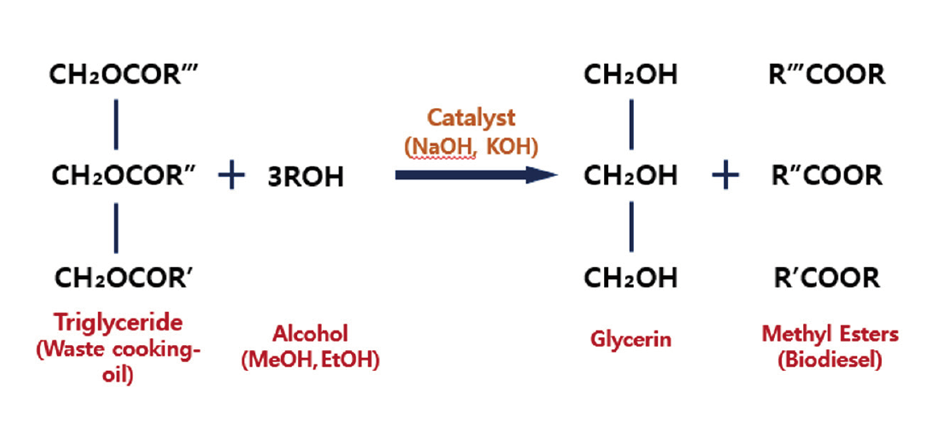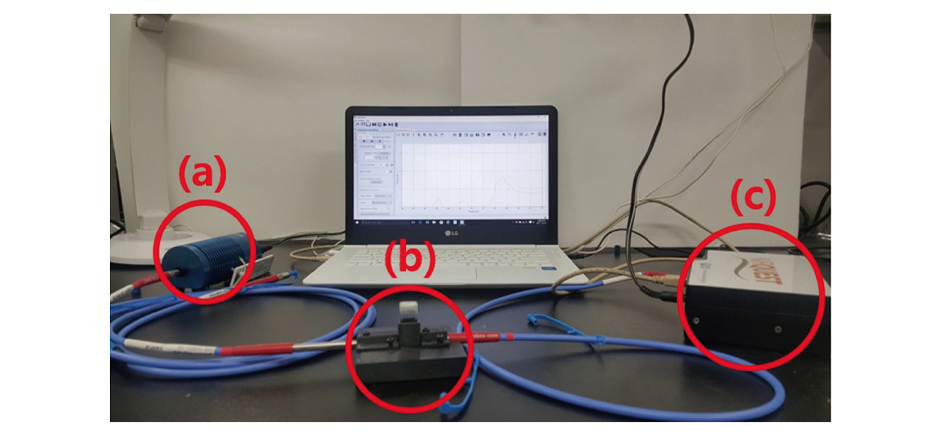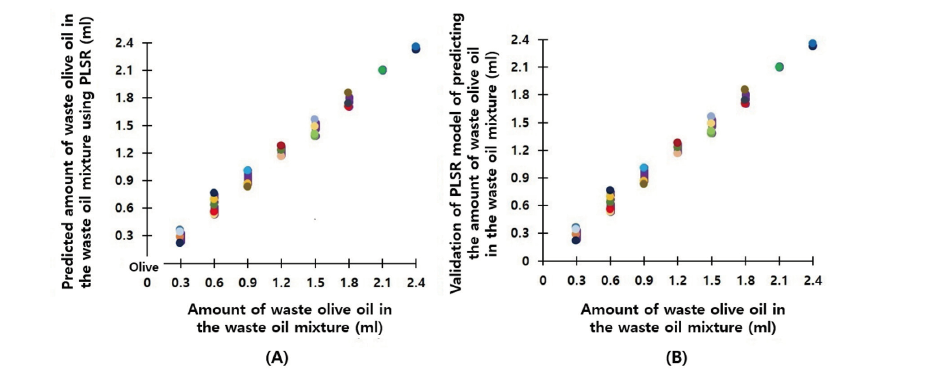Introduction
최근 환경문제에 대한 관심이 급증하고 화석연료가 점점 고갈되어감에 따라 바이오디젤은 화석연료의 대체연료로서 많은 주목을 받고 있으며 그에 따라 바이오디젤에 관한 많은 연구들이 이루어지고 있다 (Veras et al., 2010). 바이오디젤은 일반 디젤연료에 비해 이산화탄소, 황, 부유입자 등의 온실가스뿐만 아니라 공기오염의 주요 원인이 되는 물질들의 방출량이 적다. 또한 지구온난화를 가속하는 지구 전체의 탄소의 양을 증가시키지 않고 보존하는 장점을 가지고 있다 (Hill et al, 2006; Meng et al,2009; Nas and Berktay, 2007).
바이오디젤의 생산 원료로는 국제적으로 조류, 팜유, 코코넛유 그리고 여러 종류의 식용유들이 주로 사용된다(Hoekman et al., 2012). 하지만, 이 원료들의 가격이 비싸기 때문에 이 원료들을 바이오디젤의 생산원료로 사용했을 때 발생하는 생산비용이 석유디젤 생산비보다 비싸다 (Akbar et al.,2009). 그래서 바이오디젤의 대량 생산과 개발에 경제적으로 어려움이 있다 (Miao and Wu, 2006).
바이오디젤의 생산에 사용되는 기존의 생산원료를 폐식용유로 대체하는 것은 경제적으로나 환경적으로나 유리하다 (Mahesh, 2015). 폐식용유의 가격은 virgin oil의 반 정도의 가격이기 때문에 폐식용유를 바이오디젤의 생산원료로 사용한다면 바이오디젤의 생산비를 많이 줄일 수 있다 (Demirbas, 2009). 그리고 기존에 폐기 및 처리가 힘들었던 폐식용유를 바이오디젤의 생산에 사용하면 물의 오염을 줄이고 배수 환경에 도움을 줄 수 있다 (Kulkarni and Dalai, 2006).
폐식용유는 식용유의 사용량에 따라 발생량이 나라마다 다르지만 매우 큰 규모의 양의 폐식용유가 매해 배출되고 있다 (Kulkarni and Dalai, 2006). ECOFYS의 조사에 따르면 2013년 기준으로 영국을 제외한 유럽국가들에서 100만톤, 비유럽국가들(미국, 중국, 인도네시아, 아르헨티나)에서 450만톤 가량의 폐식용유를 배출했다. 그리고 전세계 인구가 증가함에 따라 폐식용유의 배출량은 앞으로 더 늘어날 것으로 추정된다 (ECOFYS, 2013).
폐식용유를 이용한 바이오디젤의 생산은 일반적으로 유지에 알코올과 촉매를 첨가하여 메틸에스테르와 글리세롤이 생성되는 에스테르 교환반응을 통해 이루어진다 (Fig.1). 에스테르 교환반응에서 주반응의 속도를 가속화하는 촉매는 알칼리 촉매 또는 산성 촉매가 널리 사용되고 알코올은 보통 메탄올이 쓰인다 (Hadiyanto et al., 2018). 에스테르 교환반응을 통해 폐식용유의 주성분인 트리글리세리드에 포함된 자유지방산은 메틸에스테로로 변환되고 이것이 곧 바이오디젤로 사용된다.
바이오디젤 생산 공정에 사용되는 식용유 원료들은 각각 구성하는 지방산의 종류가 다르고 차지하는 비율이 다르다 (Gui et al., 2008; Lam, 2010). 그러나, 이 원료들은 가열이 되어 폐식용유가 되어도 각각의 원료를 구성하는 지방산 종류마다 차지하는 비율이 크게 변하지는 않는다 (Hoekman et al., 2012; Lertsathapornsuk et al., 2008; Ferrari et al., 2005).
폐식용유의 원료가 구성하는 지방산의 종류와 원료를 차지하는 비율은 폐식용유를 이용한 바이오디젤 생산 공정에서 필요한 알코올의 양, 촉매의 종류, 촉매의 양, 반응온도 등과 같은 변수들에 영향을 주고 결국 바이오디젤 수율에 영향을 준다 (Choi, 2016). 즉, 폐식용유의 원료 혼합비가 바뀌면 혼합된 폐식용유를 구성하는 지방산의 종류와 구성비율이 바뀌기 때문에 바이오디젤 생산 공정에서의 에스테르 교환반응에 필요한 최적의 알코올의 양, 촉매의 종류 및 양 그리고 반응온도가 결정된다 (Amin et al., 2013). 그러므로 바이오디젤 생산 공정에 필요한 변수들을 선택함에 있어 폐식용유의 원료 혼합비를 먼저 아는 것은 매우 중요하다.
그러나, 식용유의 원료 분류에 대한 연구들(Veras, 2010; Sato, 1994)은 있어왔지만 폐식용유의 원료 혼합비 분석에 대한 연구들은 찾아보기 힘들다.
유지류의 정량적인 분석에는 differential thermal analyzer과 HPLC 분석, gas chromatography 등이 사용된다 (Moreira et al., 2015). 이 분석법들은 정확도는 높지만 민감도나 한계에 문제가 있고 연속적이지 않고 파괴적이다.
다른 방법으로는 신속하고 비파괴적으로 스펙트럼을 측정할 수 있는 Near-Infrared(NIR) 분광법이 있다 (Bewig et al., 1994). 유지류의 지방산의 일부를 반영하는 단일 탄소사슬과 cis 이중결합과 NIR흡광파장에 있기 때문에 NIR 분광법은 유지류의 분석에 매우 용이하다 (Sato, 1994).
본 연구는 혼합된 폐식용유의 근적외선 흡광스펙트럼 분석을 통해 폐식용유의 원료 혼합비를 연속적이고 비파괴적으로 측정하는 시스템 개발을 목표로 한다.
Materials and Methods
폐식용유 샘플 준비
폐식용유의 종류는 폐대두유, 폐해바라기유, 폐카놀라유, 폐올리브유 총 4가지로 시중에서 쉽게 얻을 수 있는 재료 순서대로 결정이 되었다. 폐대두유, 폐해바라기유, 폐카놀라유는 인근 식당에서 얻었고 폐올리브유는 생식용유를 구한 뒤 실험실에서 냉동 식품을 넣고 오랜 시간 동안 가열하여 얻을 수 있었다. 혼합된 폐식용유의 NIR 흡광도를 측정하기 위해 4가지의 원료들 중 2 ~ 4개를 선택한 뒤 총 부피가 3 ml이 되도록 각 원료들을 농도별로 다르게 조합하였다. 두 종류의 폐식용유의 원료를 혼합했을 때 60가지, 세 종류의 폐식용유의 원료를 혼합했을 때 144가지, 네 종류의 폐식용유의 원료를 혼합했을 때 84가지로 총 288개의 서로 다른 샘플을 얻었다.
혼합된 폐식용유 샘플의 NIR 흡광 스펙트럼 측정
폐식용유 샘플의 NIR 흡광도는 샘플을 12 mm 투과거리를 가진 큐벳에 두고 텅스텐 할로겐 광원을 조사한 채로 NIR 분광기 (NIRQUEST, Ocean Optics, USA)를 사용하여 898.677 nm 에서 2132.65 nm 파장대를 3 반복하여 측정하였다 (Fig. 2). Reference는 빈 큐벳의 스펙트럼을 사용하였다.
NIR 흡광도 스펙트럼 분석
획득한 흡광 스펙트럼은 혼합된 폐식용유의 샘플 내에 있는 원료의 양을 예측할 수 있는 PLSR (partial Least Squares Regression) 모델을 Unscrambler (ver. 9.7, CAMO Software, Norway)을 통해 개발하는 데 사용되었다. NIR 분광기로부터 획득한 흡광도 데이터의 파장 영역을 1,100 nm에서 1250 nm, 1,600 nm에서 1,800 nm, 1,100 nm에서 1,250 nm과 1,600 nm에서 1,800 nm, 898.677 nm에서 2132.65 nm 총 4가지 타입으로 구분하여 PLSR 모델을 개발하는데 사용하였다. 모델의 예측성에 대한 검증 방법은 cross validation을 사용하였다.
Results and Discussion
먼저 혼합되지 않은 4가지 종류의 폐식용유와 생식용유의 흡광도를 측정하였다. 획득한 흡광도 스펙트럼 데이터를 바탕으로 PCA(Principle Component Analysis) 모델을 개발하였다. 개발된 PCA 모델은 원점을 지나는 직선을 기준으로 좌측에는 생식용유, 우측에는 폐식용유의 흡광도 분포를 보여주었고 이를 통해 생식용유와 폐식용유를 구분할 수 있음을 확인하였다 (Fig. 3a). 준비된 288개의 혼합된 폐식용유의 흡광도를 측정하였다. 혼합된 폐식용유의 흡광도 스펙트럼은 혼합된 폐식용유 내 원료의 농도에 따라 가시적으로 큰 변화를 보이지 않고 개형이 비슷한 모습을 보였다 (Fig. 3b).
획득한 혼합된 폐식용유의 흡광도는 혼합된 폐식용유 샘플 내에 있는 특정 원료의 양을 예측하기 위해 개발되었다. PLSR 모델을 개발하는데 사용된 흡광도 데이터는 폐식용유를 구성하는 지방산의 구성 비율을 대변하는 NIR 파장대의 영역으로 총 4가지 타입으로 분류하였다. 첫 번째 타입에서 선택된 흡광도 파장대의 영역은 전체 파장대인 898.677 nm에서 2132.65 nm이고, 두 번째 타입은 물의 흡광도 파장을 포함하지 않는 C-H 결합의 두 번째 배음 영역인 1,100 nm에서 1250 nm이며, 세 번째 타입은 C-H 결합의 첫번째 배음 영역인 1,600 nm에서 1,800 nm이고 마지막으로 4 번째 타입은 두 번째와 세 번째 타입을 합친 1,100nm에서 1,250 nm와 1,600 nm에서 1,800 nm이다. 이를 바탕으로 각 타입마다 총 12개의 모델이 생성되었다. 생성된 PLSR 모델들은 2가지 종류의 폐식용유가 혼합된 샘플 내 특정 원료의 양을 예측하는 12개의 모델로 구성이 되어있다. 모델의 성능은 결정 상관계수인 R2와 실제값과 모델에서 예측한 값의 차이인 RMSE(Root Mean Square Error)를 사용하여 비교하였으며, 전체 파장의 흡광도 스펙트럼을 기반으로 생성된 첫 번째 타입의 PLSR 모델이 혼합된 폐식용유 내 특정 원료의 양을 예측하는데 가장 높은 성능을 보였다 (Table 1). 이는 폐식용유를 구성하고 있는 지방산의 종류와 그 구성비율이 다르기 때문에 분자 구조에 따른 C-H 배음대와 C-H 결합대의 구성비율 또한 다른데, 첫 번째 타입의 PLSR 모델은 이 영역을 다 포함하는 전체 파장을 사용하였기 때문에 모델의 예측 성능이 가장 좋았던 것으로 판단된다.
개발한 모델들의 평균값은 R2_cal = 0.987, R2_val=0.979, RMSEC=0.250으로 선형성이 높고 예측오차가 낮은 것으로 확인되었다. 생성된 PLSR 모델 중에서 가장 성능이 좋은 예측 모델은 혼합된 O-S에서 O의 양을 예측하기 위한 모델이며 R2_val=0.998, RMSEV=0.105을 나타냈다 (Fig.4). 추후 연구로는 바이오디젤 생산공장에서 본 연구에서 개발한 PLSR 모델이 실제로 적용이 가능하도록, 혼합된 폐식용유가 흐르는 상태에서 흡광도를 측정할 수 있는 방안에 대한 고찰이 필요하다.







